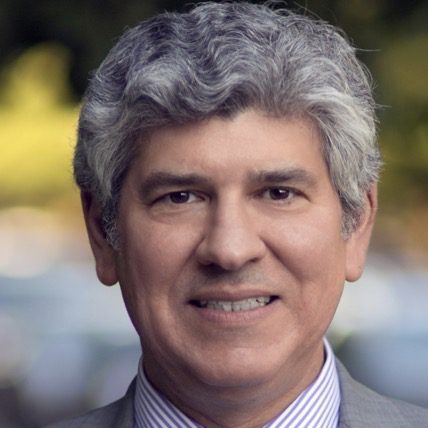Michael Sherman Interview - Real Endpoints
Until the Evidence is There: A Conversation with Michael Sherman, Point32Health
Real Viewpoints sat down with Dr. Michael Sherman, the pioneering chief medical officer at Point32Health, who shared his perspectives on coverage issues, rare/orphan diseases, and the special challenge of value-based agreements

By Roger Longman
Michael Sherman, MD, MBA, MS, the EVP and chief medical officer at Point32Health, has defined the leading edge of innovative contracting. He’s probably been personally responsible for more value-based agreements than any other executive and is often the first point-of-call for any pharmaceutical executive with an idea for a VBA. More than virtually anyone else, Dr. Sherman sees what’s working, what’s not – and where the value-based deal-making trend is heading. Real Viewpoints sat down with Dr. Sherman to talk about some of his most innovative arrangements, including his recent groundbreaking deals in oncology and genomic diagnostics.

Michael Sherman, MD
EVP & CMO of Point32Health
Real Viewpoints: You’ve done value-based agreements with drugs for prevalent diseases and for rare diseases. Which work better?
VBAs have more value in drugs for rare conditions. Not that there aren’t opportunities in common chronic conditions where the endpoints are clear. With rare conditions you’re often asked to use poorly understood “scales,” which can also be pretty subjective. But VBAs can be less important in more common diseases, which often have plenty of competition helping to keep pricing rational. And since we know more about their prevalence and the general level of efficacy, we can more readily predict total cost and average outcomes. VBAs are most useful when you’re both solving for uncertainty and you don’t have the usual competitive levers to moderate pricing. With a one-in-a-million rare condition the averages don’t apply – the outcome is binary: either it works or it does not – and there’s often no competition to keep prices in check. Nor do we have much data on durability – or efficacy for that matter, since these drugs are often approved on an accelerated pathway. That pathway is important – we want these drugs, which are often life saving, to get to patients faster. But there’s very little predictability to their value in our population and a potentially huge budget impact. And that’s why you need a VBA. And one more thing about them: as you’ve pointed out with the Real Endpoints Marketplace, these VBAs can generate real real-world evidence, which these drugs often lack since they facilitate access outside of carefully controlled clinical trials in which all parties are following a well-defined playbook.
Nonetheless, I do think we have opportunities to innovate in chronic conditions, not just using simple agreements that guarantee clinical results. You might set a global payment for all the drugs needed to treat a certain condition. Or the Netflix model – a set price for a set population.
“VBAs have more value in drugs for rare conditions.”
Real Viewpoints: We recently worked together on the VBA you did on Alunbrig, Takeda’s drug for ALK-positive non-small cell lung cancer. It’s so unusual to see an oncology VBA. Why?
Oncology is unique for a couple of reasons. First, many US states impose mandates which make it very hard for health plans to limit access to oncology drugs. Second health plans really do not want to get between the physician and the patient – particularly in oncology, where there exist a third rail for payers who are perceived as getting in the way. No health plan wants to be seen as limiting access to a potential cancer cure, even when there’s little evidence the drug works. So oncology companies haven’t felt the need to come to the table; they believe we’ll cover their drugs in any event. But the fact is that the cost of oncology – the majority of which is drugs – has become an issue too obvious to ignore, not just for individuals, but for employers and state and federal government. And that has the potential to create pressure for price regulations – hardly in the interests of the pharma industry.
Real Viewpoints: Then what made this deal doable?
Dr. Sherman: One reason is Takeda’s extraordinary leadership. Unlike many of their peers, they recognize oncology’s cost and evidence challenges and the consequences of not addressing them. And they were willing to do the work to figure out how to execute the VBA so it works efficiently. Certainly, the deal was helped by the fact that the drug is indicated for a well-defined population. But we also created an elegant definition of success. Outcome measures can be complicated for oncology – greater progression-free survival, greater complete response, and so on. These metrics require gathering difficult-to-collect information at a not insignificant administrative cost.
The Takeda agreement, on the other hand, is easy to implement and effectively measures the drug’s value to patients, that is, whether they’re continuing to take it. If someone discontinues an oncologic after starting it then presumably it’s not working or its side effects make it impossible to stay on it. So if the patient doesn’t take it for a minimum number of days, the plan gets a substantial rebate. That’s fair. And it shows oncologists and other stakeholders that Takeda is willing to stand behind their drug, which is a competitive advantage for the manufacturer.
The Takeda oncology deal is the “first of its kind [and] sends a message to the industry that, even in oncology, these deals are do-able.”
I’m not pretending that this deal will solve our healthcare financing challenges but it is more than just a step in the right direction. It’s the first deal of its kind – it sends a message to industry that, even in oncology, these deals are do-able, that we can promote access that better aligns what we pay with what how the drugs perform. I hope sincerely that others choose to follow suit.
Real Viewpoints: Do you think they will?
Takeda is getting credit from a number of payers for doing this. That gives them an advantage over their competitors. And to the extent that pharma companies are worried about government policies that may adversely impact drug pricing, deals like this would appear to provide a better solution for them than more draconian government actions. I’m cautiously optimistic. On the other hand, we’ve had a lot of meetings with oncology companies – and no agreements until Takeda’s.
Pharmaceutical “companies don’t really know the payers.”
But to be fair, deals like this are not a native skill for many pharmaceutical companies. They don’t really know the payers. And their organizations are complex – and certainly have gotten in the way of simple execution. For both these reasons, that’s why I think it was important here to have an expert third party, like Real Endpoints in this transaction, playing a crucial role, helping both sides understand each other’s concerns and focusing on the meaningful details that get these agreements over the line.
Real Viewpoints: Michael, you’ve also innovated in genomics, signing two very novel risk-sharing deals with Illumina. Since you’ve done two deals with the same company, I assume that means you believe they’re a good partner. Why?
It’s a cliché, I know, but it’s all about the relationships. Does the partner care about the things you do? Like us, Illumina is focused on the data; like us, they want to solve clinical problems. And they’ve proven it to us, and I think we’ve done the same for them. So, we trust each other. I also think it helps that Real Endpoints was involved on the structuring, in getting us over the inevitable rough patches, and as an objective third party, managing all the data and financial reconciliation.
Real Viewpoints: Unlike most of your deals, both Illumina deals have economic endpoints: defining the manufacturer’s risk as cost over a baseline, not some clinical parameter. Is that a good model for pharma?
Dr. Sherman: Sure – sometimes. In the Illumina cases, where we were substituting genomic approaches for less informative ones, differential health outcomes would have taken a long time to uncover. Cost, on the other hand, is relatively easy to measure. Clearly, we’d like to do both – measure cost simultaneously with clinical benefit.
Now I recognize that new technology can increase costs. Illumina’s NIPT [non-invasive prenatal testing] assay is more expensive than serum tests. But what’s clever is that the deal looks at total testing costs, not just the substitution cost of NIPT for a particular test. And I think we could do something similar in pharma, where, yes, a drug may be more expensive than its alternative, but you could benchmark the overall cost of the disease – controlling diabetes, for example, or COPD – and share risk around that. That lets us get away from paying for a specific pill and the whole costly administrative burden of prior authorizations. It lets the physician make the right decision in conjunction with a patient; it allows the pharma company to innovate and rewards franchises. It’s a beautiful model.
Risk sharing around the overall cost of the disease “let us get away from paying for a specific pill and the whole costly administrative burden of prior authorization.”
I also recognize the bureaucratic and financial complexities – like whether such deals would violate existing rebate agreements. But there are certainly categories where it would work very easily, including in some of the rarer diseases where rebating is minimal, but competition is heating up. For example, in hemophilia – a one-time fee that covers, say for five years, not merely the gene therapy but any additional costs for “topping off” with factor or other needed care.
Real Viewpoints: Do VBAs help Point32 commercially?
We haven’t trumpeted them to our customers as much as perhaps we should have, but they do send a message to employers, members, and physicians that we are a leader in innovatively managing quality and cost, not just cost. It helps differentiate us from our competitors.
Real Viewpoints: Can beneficiaries get copay money back in a VBA?
Yes. Or rather, yes but. We did one cardiovascular VBA in which individuals who had a heart attack would get their expenses reimbursed. As it turned out, there were no events within the specified time frame so neither we nor any beneficiaries collected on the risk share – which after all is a good thing. So members can participate. And that’s true with the Takeda arrangement as well. But in reality, most members with severe conditions like cancer have already gone through their deductibles and reached their maximum-out-of-pocket expenditures; so, relative to a specific VBA, they are unlikely have a cost-share expense. But if they did, they would absolutely share in the refund in this type of agreement.
Real Viewpoints: Last question: what happens if – at least in rare diseases – biopharmas don’t want to offer VBAs?
I’d point you to Adhuhelm, which I think may represent an inflection point in payer/biopharma relations. This was the first new approved therapy for Alzheimer’s – with plenty of publicity around it, plenty of patient and physician interest. But our clinical experts didn’t believe that the efficacy data was strong enough to outweigh the risks. And so we were at least one of the first plans to say: “no, we won’t cover the drug – until the evidence is there.” I recognize that this is not a rare disease. But my point is: plans are learning they can say “no” even in highly emotional cases when they feel the data doesn’t yet support coverage. That’s especially true for rare diseases with modest data sets, particularly as we see the competition in these categories heating up.

